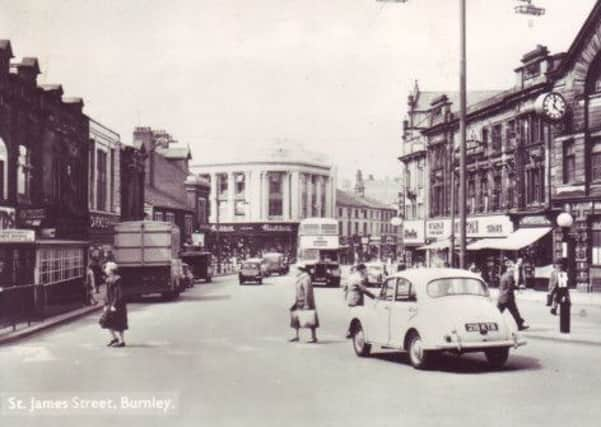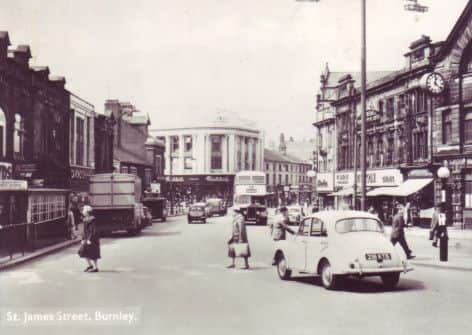A St James’s Street trip


These photographs often show trams rather than motor vehicles so I have been asked to select some images of a later era and this is what I have done today.
As you will know, St James’s Street is a long thoroughfare. In fact it used to be known, or more precisely sections of it, by at least four different names.
Advertisement
Hide AdAdvertisement
Hide AdThe initial 100 yards or so was Blucher Street, after the Prussian general whose appearance on the battlefield at Waterloo turned Wellington’s victory over Napoleon into a rout.


Then there was St James’s Street, which ran to the Curzon Street/Hammerton Street junctions, after which the names Goodham Hill and Cheapside took over.
This article will concentrate on the part of St James’s Street which contains the lower numbers, the part which once contained Blucher Street.
The street itself used to start where Church Street began. This was at the top of Hall Street, formerly Hall Rake, but, as you will know, when the Kierby Hotel was opened in 1958, the initial part of Church Street was renamed Keirby Walk.
Advertisement
Hide AdAdvertisement
Hide AdThe numbers on St James’s Street continue in a westerly direction. Many of you will remember Poole’s Silk Shop. It was at 1 St James Street though I have not included a good picture of this building. However, it is included on three or four of the later images.
On the other side of the street, number 2, and I have gone back to 1953, was divided between two business, Brown’s snack bar and Frank Pick’s chemists shop. Then there was Cliviger Street, after which number 4 was the premises of C. F. Hargreaves Ltd, better known as the “Golden Padlock”, who were hardware merchants. After that there was Hesketh’s, who were cabinet makers; Cort’s, who were carpet dealers and, a shop I knew well, Lupton Brothers, who were booksellers and stationers. Next door was Stockdale’s (Burnley) Ltd, the toy dealers.
There was a certain amount of rivalry between Lupton’s and Stockdale’s because Lupton’s sold toys on the first floor at number 12. When I worked at Lupton’s, as a student, the book shop was on the ground floor with the stationery department behind. To get to the toy department, which often was very quiet, the customer had to climb some stairs, towards the back of the shop, but the effort was usually worth it, especially on the days close to Bonfire Night or, after that, on the run-in to Christmas.
In those days (I worked at Lupton’s in the 1960s) the emergence of temporary specialist fireworks shops had not yet taken place and lots of shops sold fireworks. The bigger stores, like Lupton’s, stocked, as well as the more common fireworks, more sophisticated lines. I used to enjoy looking at the new stock as it came in, though I was often shocked at the prices, and it was not long before I could predict which of the products were unlikely to remain unsold.
Advertisement
Hide AdAdvertisement
Hide AdOf course, there were not only shops in this part of St James’s Street. In 1953, there were five public houses on the even side of the street. They were, the Boot Inn, at the corner of Parker Lane; the White Lion, opposite; the Clock Face at 32 St James’s Street; the Swan Hotel, at 46 St James’s Street and the Old Red Lion, which was technically on Manchester Road.
There were no public houses on the odd side of St James’s Street but, after Poole’s, who were at 1 to 3 St James’s Street, number 5 was occupied by the local offices of the Ministry of National Insurance.
In the 1953 Directory number 5 appears to have been shared with Elim Hall which occurs in a number of other Directories before that date. However, all I can suggest about it is that it was a place in which meetings, possibly religious, were held. Elim is mentioned as a place name in the Bible and there was, and there still might be, a national Elim Pentecostal Church. In Burnley, there is an Elim View at Lane Head. It may be that these premises, at a later date, were taken as the local office of the Ordnance Survey. I recall the sign on the wall.
On the odd side of St James’s Street, in 1953, there was the Grand Super Cinema, the Palace Theatre and Cinema, Burnley Council’s Public Health Office and the Council’s Tramways Department, or at least that is what the Directory informs us. By 1953, the trams had long since been replaced by buses and it was from the former tramways office that Burnley, Colne and Nelson buses were run. It was to this building that the famous clock that you can see in some of the pictures was fixed.
Advertisement
Hide AdAdvertisement
Hide AdThe rest of the odd side of St James’s Street, to Bridge Street, contained a number of well known shops, such as the BSK Café, Timpson’s shoe shop, Cowgill and Smith’s ironmongers, Addison’s wine merchants, Dunkerley’s shoes, and Waller and Richardson’s costumiers. There were also a number of offices of insurance companies. These include the Road Transport and General Insurance Co Ltd, which occupied the upper floors of number 35, and the Co-operative Insurance Society, which occupied part of the upper floor of Addison’s shop.
Mentioning these insurance offices reminds me that, until quite recently, many of the larger towns had a number of sizeable insurance offices. It was this factor that attracted by grandfather to Burnley. He came to town from Kendal, via Bolton, to become manager of the Burnley office of the Britannic Assurance Co. When the local insurance offices closed down it is likely that a number of jobs would have been lost in places like Burnley. These days much insurance business is done “on line”.
So you can see how varied the part of St James’s Street we have been looking at today was, perhaps, 50 or 60 years ago.
I have to admit that this is how I prefer streets to be and, for me, it was a mistake to get all the shops together in one place; the banks, estate agents and building societies in another with pubs, clubs and similar venues in a third.
What the reasoning was behind all these changes is beyond me and I feel that we have all lost something since the days when things were allowed to develop without too much Municipal interference.